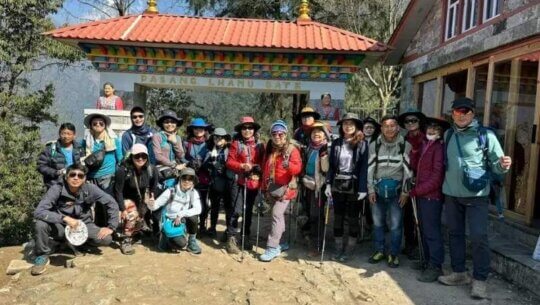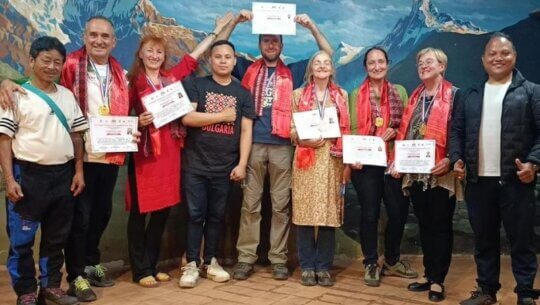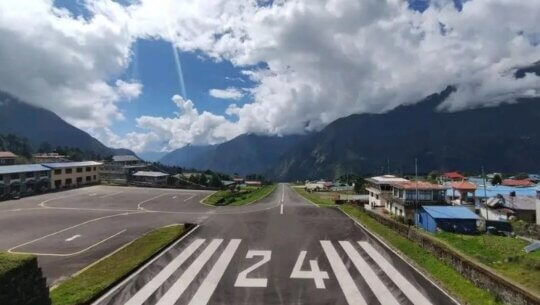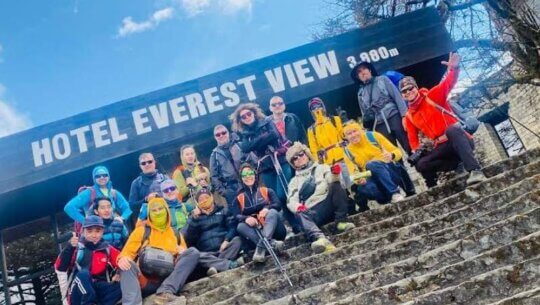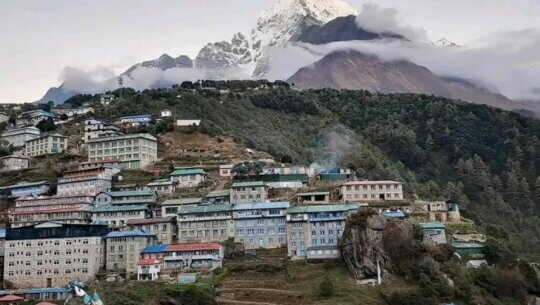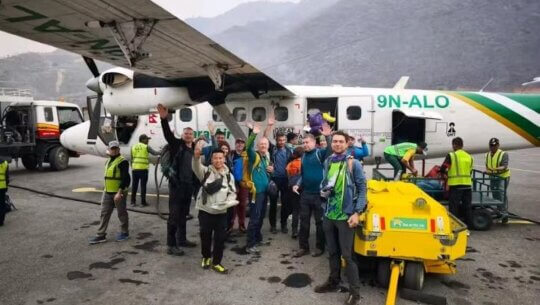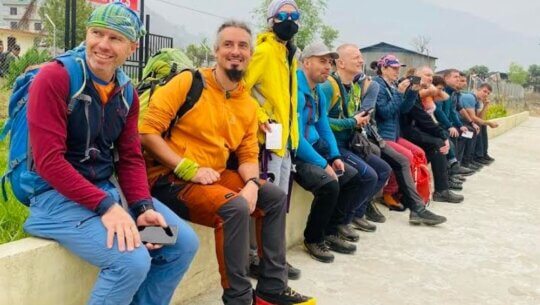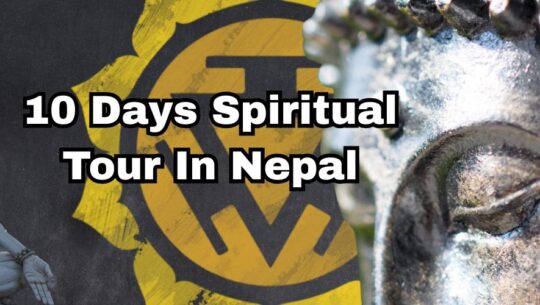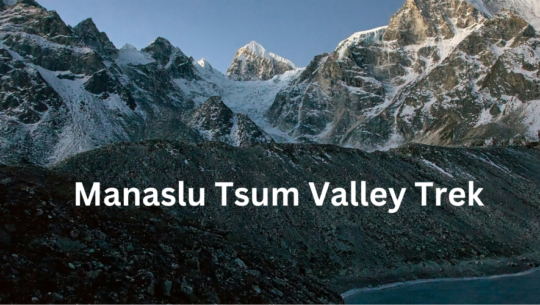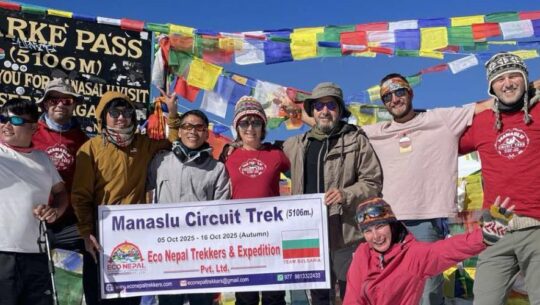Everest View Trek – 8 Days
TripAdvisor Reviews Recommended by 99.99% travelers
USD 1150
Nepal
8 Days
Moderate
3880m at Hotel Everest View
Hotel/Tea house/Guest house
private vehicle/Flight/Bus
2-20
Feb, Mar, Apri, May, June, Sep, Oct, Nov & Dec.
- Everest View Trek offers breathtaking views of Everest, Ama Dablam, Lhotse, Thamserku, and Kongde Ri from classic angles.
- Wander around the lively Sherpa “capital”, Namche Bazaar.
- Get a glimpse into Sherpa culture by visiting the cultural museums and local monasteries, such as Tengboche Monastery.
- Trek inside Sagarmatha National Park, the UNESCO World Heritage site, and get to see rare wildlife like the Himalayan Tahr and the Himalayan Monal.
- Get the opportunity to explore the world’s highest placed hotel, Hotel Everest View.
- Capture the big-mountain beauty in 8 days with a max altitude of 3,870m.
- Get to enjoy a scenic and thrilling flight from Lukla to Ramechhap
Everest View Trek – 8 Days Brief Insight
Do you really have to spend weeks at a very high altitude just to see Mount Everest? The quick answer is: No.
With our Everest View Trek package, you will be able to experience the view of the world’s highest mountain without reaching the Base Camp.
In just 8 days, you’ll fly into the mountains, walk through Sherpa Village, and visit monasteries.
But first, here is what the Everest View Trek is all about.
Everest View Trek is the shorter and easier alternative to the Everest Base Camp trek. Instead of hiking for 10 to 12 days, you can hike for 4 days to Hotel Everest View (3,880 m), offering a bird’s-eye view of Mt. Everest, Ama Dablam, Lhotse, and Thamserku.
Unlike EBC, where you have to ascend to 5,364m, in this trek, the maximum altitude you will reach is 3,880m. This means that altitude risk is much lower, and you still get 80% of the views and culture.
Due to its reduced risk and limited time, this trek would be perfect for:.
- Families with kids who can hike for a few hours a day.
- First-time trekkers who want a safer Everest Experience.
- Busy Travellers who only have a week in Nepal.
- Older folks with a wish to see the world’s Highest Mountain.
Besides that, the well-maintained trails within Sagarmatha National Park also make this trek much safer for average trekkers. Furthermore, you’ll cross some exciting suspension bridges and explore the last market of the Everest region, Namche Bazaar. This whole combination of joy, views, culture, and comfort makes your Everest dream achievable in a smart and doable way.
- Day 1: Arrival and Welcome at Kathmandu
- Day 2: Drive to Ramechhap, Fly to Lukla & Trek to Phakding
- Day 3: Trek from Phakding to Namche Bazaar
- Day 4: Arrival at Hotel Everest View & Return to Namche
- Day 5: Trek from Namche to Tengboche Monastery
- Day 6: Trek from Tengboche back to Namche Bazaar
- Day 7: Trek from Namche Bazaar to Lukla
- Day 8: Fly from Lukla to Ramechhap & Drive to Kathmandu
Detailed Itinerary
Day 1: Arrival and Welcome at Kathmandu
Trek Distance :
N/A
Highest Altitude :
1,350 m/4,429 ft at Kathmandu
Trek Duration :
N/A
Meals :
Breakfast
On the day of your arrival in Nepal, we will receive you at the airport.
Then, we will transfer you to the Hotel where you will be spending your first night in Kathmandu.
After getting freshened up, we will arrange your meeting with the guide. During that time, our experienced guide will give an Everest View Trek briefing. Afterwards, we move towards sorting all the permits.
Then, we will do the last-minute gear check.
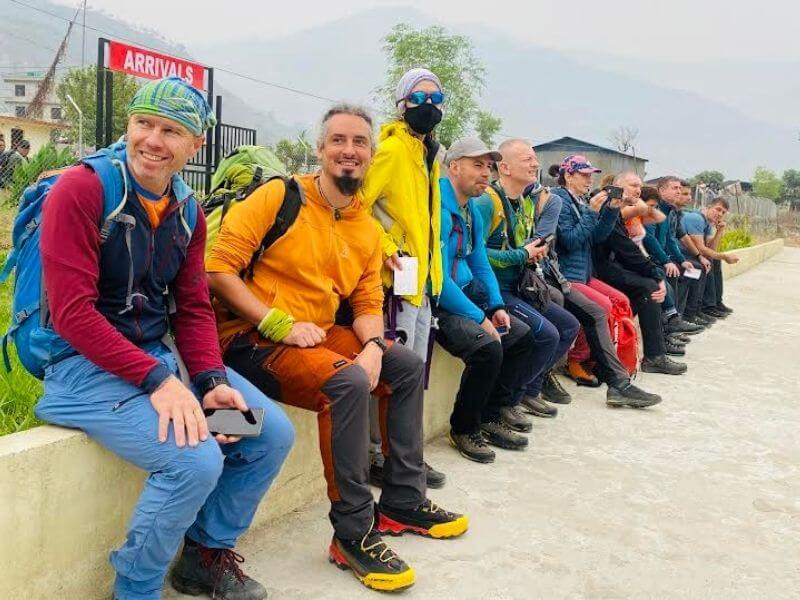
Day 2: Drive to Ramechhap, Fly to Lukla & Trek to Phakding
Trek Distance :
8 km
Highest Altitude :
2,850 m/9,350 ft at Lukla
Trek Duration :
4-5 hrs(drive); 25 mins(flight); 3-4 hrs (trek),
Meals :
Breakfast /Lunch /Dinner
Your day 2 starts early in the morning, around 1 am, with a 3 to 4-hour scenic drive from Kathmandu to Ramechhap. During the drive, we will enjoy the views of rural landscapes, cultural sites, and rivers.
After arriving at Ramechhap, we will take a flight to the legendary Lukla airstrip, which takes approximately 20-25 minutes. While flying from Kathmandu might be possible, due to heavy air congestion and ongoing maintenance at Kathmandu airport, flying from Ramechhap is the safest available option.
But our day two doesn’t end here; from there on, we head down to the Dudh Koshi River valley. By passing through pine forests and little stone villages, we reach our final destination of the day, Phakding. From Lukla to Phakding, we will face the descent of 199m (from 2,850m to 2,651m).
By the end of the day, you would have covered around 8 km (4.9 miles) by trekking for 3 to 4 hours.
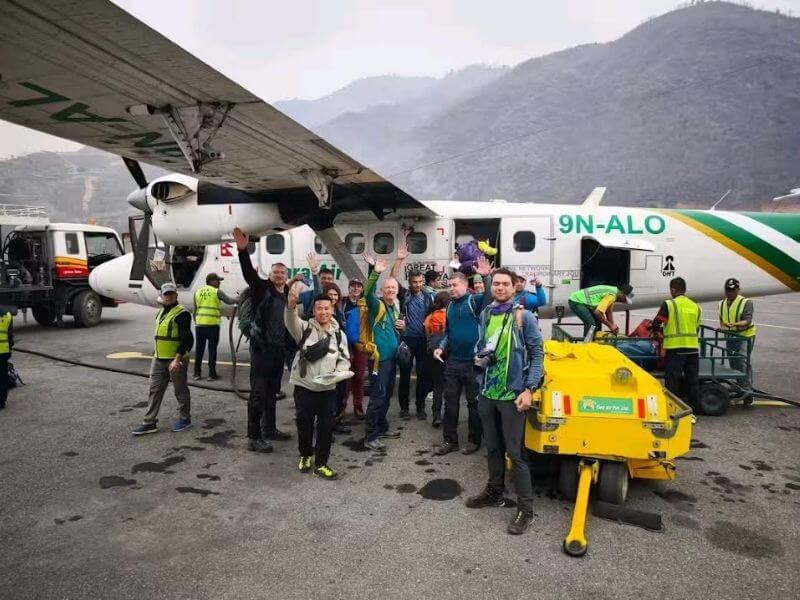
Day 3: Trek from Phakding to Namche Bazaar
Trek Distance :
7.4 km
Highest Altitude :
3,440m/11,286 ft at Namche Bazaar
Trek Duration :
5-6 hrs
Meals :
Breakfast /Lunch /Dinner
This day will be the most exciting and challenging part of the trek.
Together, we will cover 7.4 km (4.6 miles) in about 5 to 6 hours. As we will be climbing from 2,651m at Phakding to 3,440m at Namche, today we will have a significant elevation gain of 789 m.
Our day starts by passing small Sherpa villages like Benkar before reaching Monjo.
Then, you’ll officially enter Sagarmatha National Park, a UNESCO World Heritage site, after permits are checked.
Our trail then leads to Jorasalle, the last village before Namche, and our stop for lunch. After lunch, we start to cross the iconic Hillary Bridge.
At around 3,200m, there is a viewpoint. If we get blessed by the weather, we will catch our first glimpse of Mount Everest there.
Nevertheless, by afternoon, we will reach our final destination for the day, Namche Bazaar.
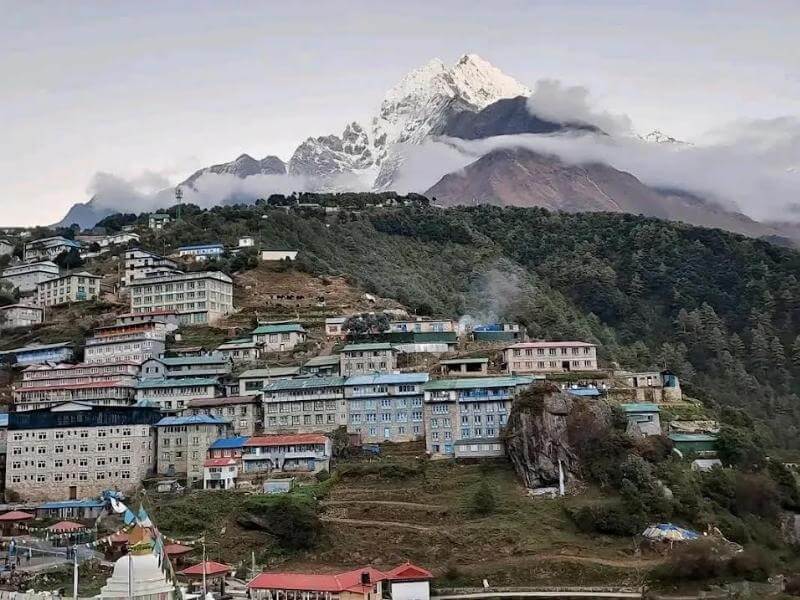
Day 4: Arrival at Hotel Everest View & Return to Namche
Trek Distance :
5.4 km round trip
Highest Altitude :
3,880 m / 12,729 ft at Hotel Everest View
Trek Duration :
3-4 hrs
Meals :
Breakfast/ Lunch /Dinner
Today will be the day when we finally reach Hotel Everest View.
After spending a night in Namche, we start our day by visiting Khumjung Village (3,790 m). There, we will stop by Khumjung Monastery and see the famous Yeti Scalp. From there, our journey will lead us towards the Hillary School, built by Sir Edmund Hillary.
Now, we begin our expedition towards the highlight of our trip, Hotel Everest View (3,880m).
From the hotel’s terrace, we’ll enjoy breathtaking panoramic views of Everest, Ama Dablam, Lhotse, and Thamserku.
After spending more than an hour, we will start returning to Namche. In the evening, we stop by to explore some cultural attractions such as the Sherpa Culture Museum.
Today, we will have an elevation gain of 440 meters and cover 5.4 kilometers on a round trip.
Talking about the time, the uphill hike to Hotel Everest View takes around 2 to 2.5 hours, and the descent back to Namche takes about 1 to 1.5 hours.
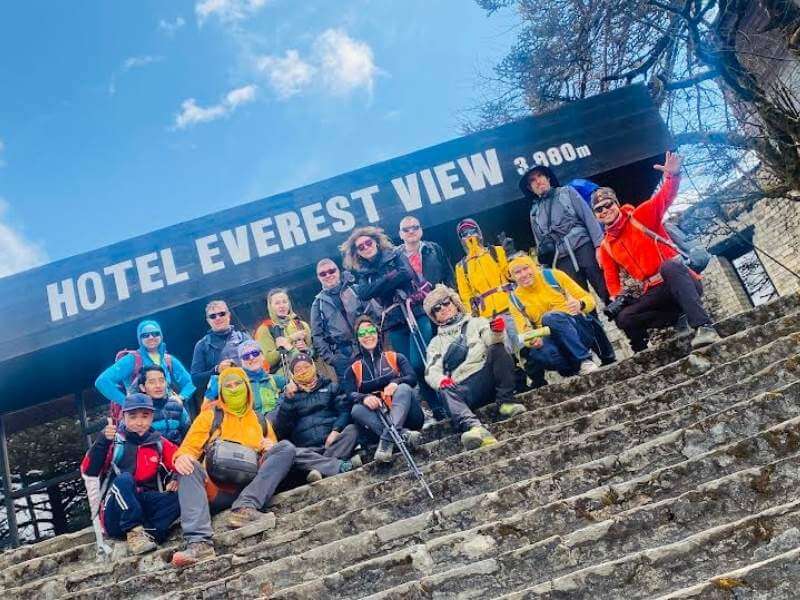
Day 5: Trek from Namche to Tengboche Monastery
Trek Distance :
9.6 km
Highest Altitude :
3,867 m / 12,687 ft at Tengboche
Trek Duration :
5-6 hours
Meals :
Breakfast /Lunch /Dinner
Today, we will go deeper into the heart of the Khumbu region. This trek will be both physically and spiritually rewarding.
The day begins with a challenging 570m descent to the Dudh Koshi River. Along the way, we will pass Kyangjuma Village (3,550m). The village is quite famous for stunning views of Ama Dablam and its traditional tea houses.
After that, we will continue descending to Sanasa (3,170m), the lowest point of the day, before reaching Phunki Tenga (3,250m).
Now, the most challenging part begins as we start to approach Tengboche Monastery.
At 3,867m, Tengboche offers a peaceful setting with unobstructed views of Everest, Lhotse, Ama Dablam, and Thamserku. If you’re lucky, you may witness the monks’ morning prayers or even the famous Mani Rimdu Festival in October or November.
By the end of day 3, you will cover around 9.6 km by trekking for 5 to 6 hours. The net elevation gain will be 427m, but the total gain will be 878m due to an initial steep descent.
Day 6: Trek from Tengboche back to Namche Bazaar
Trek Distance :
9.6 km
Highest Altitude :
3,867 m / 12,687 ft at Tengboche start point
Trek Duration :
4-5 hrs
Meals :
Breakfast /Lunch /Dinner
While returning to Namche, we will follow the same route as day 5. However, the trek in itself will feel slightly easier as most of it will be downhill.
Our day actually starts with a descent through rhododendron and pine forest. Then, after about 2 hours, we will reach Phunki Tenga (3,250m) for a rest and a quick tea break.
While enjoying the view of the mountains, we will reach Namche Bazaar in about 4 to 5 hours.
By the end of the day, we will have covered approximately 9.6 kilometers.
Day 7: Trek from Namche Bazaar to Lukla
Trek Distance :
18 km
Highest Altitude :
3,440m/11,286 ft at Namche Bazaar
Trek Duration :
6-7 hrs
Meals :
Breakfast /Lunch /Dinner
This is the longest trekking day of the journey, covering 18 km (11.2 miles) over 6 to 7 hours, as you descend 600m from 3,440m at Namche to 2,850m at Lukla. While it’s mostly downhill, the sheer distance makes it a moderate challenge.
The trek retraces familiar paths along the Dudh Koshi River, passing through places you’ve come to know well.
You’ll cross the iconic Hillary Bridge (2,885m) one last time (perfect for a final photo), then pass through Jorsalle and Monjo Village, where you’ll officially check out of Sagarmatha National Park.
Then we will stop for lunch at Phakding (2,651m) before continuing the final push to Lukla. This day brings mixed emotions; relief at completing the trek, combined with a bit of sadness at leaving the Himalayas behind.
In Lukla, you can celebrate with your team and prepare for the flight back to Kathmandu.
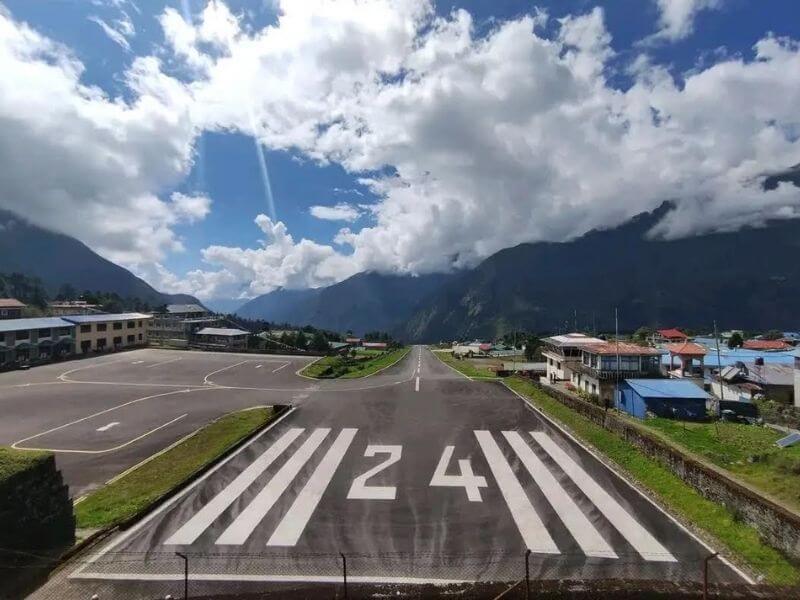
Day 8: Fly from Lukla to Ramechhap & Drive to Kathmandu
Trek Distance :
N/A
Highest Altitude :
2,850 m/9,350 ft at Lukla
Trek Duration :
25 mins(flight); 4-5 hrs(drive)
Meals :
Breakfast/ Dinner
This will be the last day in the Everest Region. Today, we will take a 12 to 25-minute flight from Lukla to Ramechhap.
During the flight, you can enjoy all the views of the mountains from the sky. Then, after reaching Ramechhap, we will head back to Kathmandu and meet for our farewell dinner.
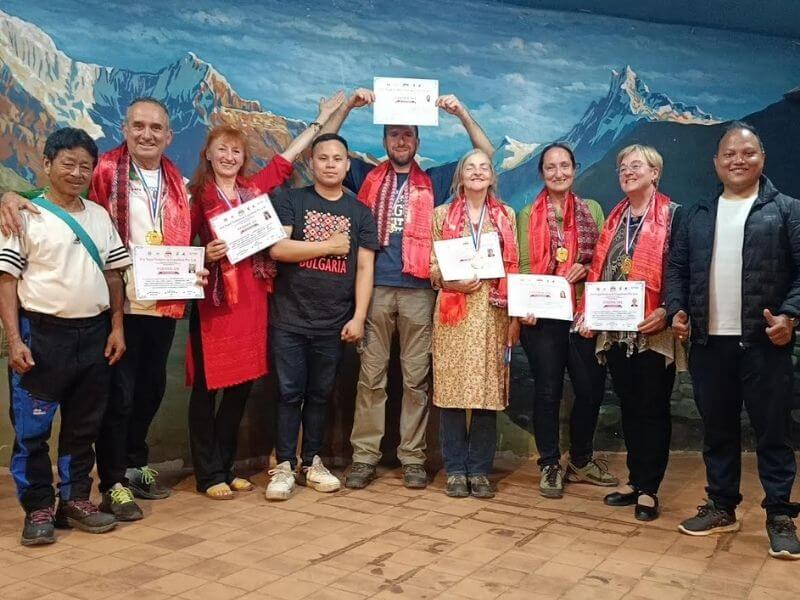
Cost Includes
- Licensed English-speaking guide and local porter (shared)
- All required permits and paperwork
- Round-trip flights: Ramechhap to Lukla
- Kathmandu to Ramechhap Manthali transportation
- Trek accommodation in clean, twin-share tea houses
- Three meals per day on trek (1-breakfast, 1-lunch, 1-dinner)
- Three cups of tea or coffee daily during the trek
- Seasonal fruits are served every evening during the trek
- Airport transfers, pre-trek briefing, and emergency support plan
- First-aid kit, pulse oximeter checks, and basic safety monitoring
- Farewell dinner at the end of the trek
- Trek achievement certificate
- All company taxes and service charges
Cost Excludes
- Nepal visa and international flights
- Travel insurance with helicopter rescue (mandatory)
- Personal trekking gear (rentals available)
- Wi-Fi, hot showers, and device charging
- Water, beverages, snacks, and other personal expenses
- Tips for the guide and porter
Permits & Rules for Everest View Trek
To trek in the Everest region, you’ll need two essential permits, both of which we will arrange for you to make the process hassle-free.
Sagarmatha National Park Entry Permit
- Cost: USD $30 per person (free for kids under 10)
- Validity: Up to 4 weeks
Where Issued:
Kathmandu at the Nepal Tourism Board (NTB) office, or at Monjo or Lukla checkpoints along the trail.
Khumbu Pasang Lhamu Rural Municipality Permit
- Cost: USD $20 (NPR 3,000) per person
- Validity: Up to 4 weeks
Where Issued:
- At Lukla or Monjo checkpoints upon entry into the region.
Both permits are checked at multiple points along the route, so keep them safe and easily accessible throughout the trek.
Furthermore, these fees directly support conservation efforts, trail maintenance, and local community development, ensuring the region stays beautiful for future trekkers.
By the way, did you know these are the same permits that you require for trekking on Everest Base Camp?
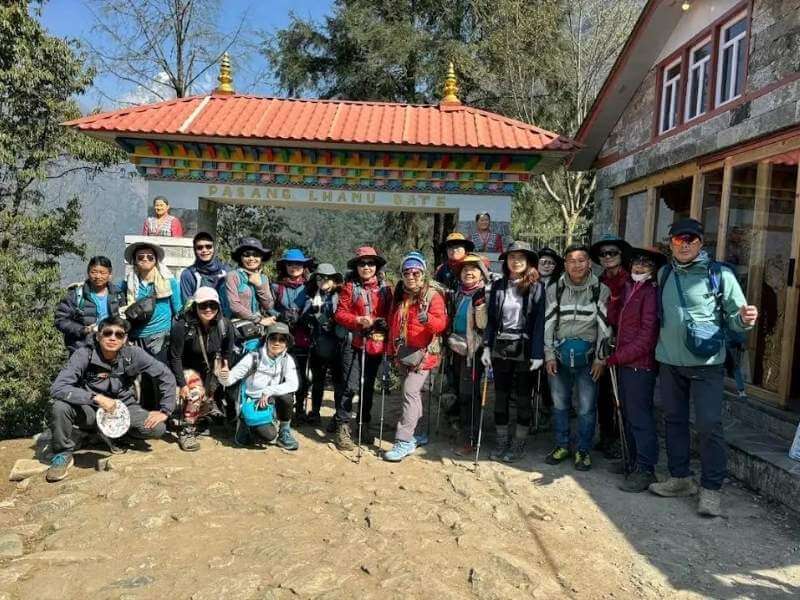
Best Time For Everest View Trek
Choosing the right season in Everest View Trek can make a huge difference in your trekking experience.
Autumn (Sep–Nov):
It is a top choice because of crystal-clear skies, stable weather, and perfect photography conditions.
- Daytime temperatures: 10–15°C at Namche
- Nights: Around freezing point
Spring (Mar–May)
It is the second-best choice because of warmer weather with rhododendrons in full bloom and good views.
- Daytime temperatures: 15–20°C
- Some afternoon cloud cover is common
Winter (Dec–Feb):
This season is only good if you can handle the harsh weather. During this season, you will find very quiet trails and beautiful snowy landscapes, but bear in mind that lodge services during this season will be limited.
- Nights: –10°C to –20°C higher up
Monsoon (Jun–Aug):
We do not recommend this period due to clouds that hide the mountains, muddy and slippery trails, and often delayed flights.
Pro Tip: Mountain views are clearest in the early morning. Plan your Hotel Everest View sunrise hike for the best photos.
The best season for the Everest Base Camp and the Everest View Trek is actually the same.
How Hard Is the Everest View Trek?
This trek is rated moderate. You should be ready to walk 4–6 hours per day on uphill and downhill trails with plenty of stone steps.
- Training: Start 8–12 weeks before with hikes, stair climbs, and practice walks carrying a light backpack.
- Altitude: The maximum height is 3,880m, which has a much lower altitude risk than Everest Base Camp. We include a full acclimatization day in Namche to keep you feeling great.
By the way, if you want a comprehensive preparation guide, you can check our blog on ‘How to Prepare for Everest Base Camp,’ as it also covers the Everest View Trek.
Where You Sleep & What Will Be Your Meals In Everest View Trek?
During the trek, you will be staying in the local tea-houses.
Tea House Stay offers:
- Cozy, family-run lodges with twin rooms and clean bedding (bring a sleeping bag for warmth)
- Shared bathrooms are common, with some private rooms available for extra cost
- Heated dining rooms with a wood stove, but bedrooms are unheated
Meals You’ll Love:
- Dal Bhat – rice, lentil soup, and veggies (often with free refills)
- Sherpa stew, noodles, momos, pasta, eggs, and pancakes
- Hot tea, coffee, or lemon drinks to keep you warm
Typical Costs if You Buy Yourself:
- Breakfast: $5–9 | Lunch/Dinner: $6–12
- Wi-Fi: $5–12/day | Hot shower: $5–7/use | Device charging: $3–5/session
Luxury Option: Hotel Everest View – $200–$400/night with gourmet meals and unbeatable views (book early in peak season).
Dietary Needs: Vegetarian, vegan, and gluten-free options available — let us know in advance.
SIM & Charging
- Mobile Coverage: In Nepal, there are two major providers, NTC and Ncell. NTC has the best coverage overall. On the other hand, Ncell works well at lower altitudes but is patchy above 3,800m. By the way, if you travel with us, we will provide you with the SIM card for free as well.
- Wi-Fi: The Everest Link network is available in most lodges. However, they are only good for messaging and emails.
- Charging: Every lodge can charge devices for a small fee. But we recommend you bring a power bank for backup.
Little Info About the Availability Of Cash in the Everest Region
- Bring enough Nepalese Rupees from Kathmandu.
- ATMs in Namche are available but unreliable.
Pro Tip: Download offline maps and update family once a day, usually in the evening.
Health, Safety & Acclimatization
Altitude Basics:
At 3,880m, most trekkers feel fine thanks to our slow pace and acclimatization day.
- If you feel mild symptoms like a headache or tiredness, drink water, rest, and inform your guide.
- If symptoms worsen, we descend immediately; safety comes first.
Warning Signs:
If you experience these signs, please do inform the guide:
- Mild: Headache, dizziness, poor sleep
- Serious: Trouble breathing at rest, confusion, vomiting
Insurance:
- Travel insurance covering up to 6,000m and helicopter evacuation is required.
- Clinics are available in Namche and Pheriche (seasonal).
Hydration & Nutrition:
- Drink 3–4 liters of water daily.
- Avoid excessive alcohol — it worsens acclimatization.
- Diamox can help with altitude, but consult your doctor first.
We provide first-aid, monitor oxygen levels, and follow safe “climb high, sleep low” practices.
Nature & Wildlife In the Everest View Trek
Trekking through Sagarmatha National Park means you’ll enjoy beautiful landscapes of rhododendron forests, alpine meadows, and dramatic valleys.
Wildlife you may encounter:
- Himalayan Tahr – wild mountain goats on steep slopes
- Musk Deer – shy, usually seen at dawn or dusk
- Himalayan Monal – Nepal’s colorful national bird
Rare sightings of snow leopards or red pandas (very uncommon, but thrilling if spotted)
Sherpa Culture Exploration In the Everest View Trek
The Sherpa people are renowned for their mountaineering skills and deep Buddhist traditions. Along the trail, you’ll pass mani walls, prayer flags, and chortens (stupas).
Tengboche Monastery (3,860m):
- The spiritual heart of the region and one of Nepal’s most famous monasteries.
- Daily prayer ceremonies are open to respectful visitors.
- If you visit during the Mani Rimdu Festival (Oct–Nov), you’ll see vibrant mask dances and rituals celebrating the victory of good over evil.
In Namche, visit the Sherpa Cultural Museum and shop at the Saturday Market for local cheese, handicrafts, and unique souvenirs.
Packing List For Everest View Trek
Clothing System:
- Base layers (moisture-wicking tops/thermals)
- Fleece midlayer + down jacket (rentable in Kathmandu)
- Waterproof jacket and rain pants
- Trekking pants, warm hat, sun hat
- Gloves (thin liners + warm pair)
- Wool or synthetic socks (3–4 pairs)
Footwear:
- Hiking boots with ankle support (most important item)
- Comfortable camp shoes for evenings
Gear:
- 40–50L backpack with rain cover
- Trekking poles (rentable)
- Sleeping bag rated to –10°C (rentable)
- Headlamp, power bank, basic toiletries
- Water bottles or hydration bladder (2L total) + purification tablets or filter
Rental Tip:
Down jackets, sleeping bags, and poles are easy to rent in Kathmandu, saving you weight and cost.
Fitness Prep:
Start 8–12 weeks before your trek with hikes, stair climbing, and short walks carrying a backpack.
Eco-Conscious Travelling Tips for Everest View Trek
- Avoid single-use plastic bottles — purify tap or boiled water instead.
- Carry out your own trash — even small items like candy wrappers.
- Support eco-friendly tea houses that use solar energy and proper waste management.
- Treat your guides and porters fairly and respectfully — our packages include fair wages and insurance.
- Be quiet and respectful in monasteries; remove shoes and ask before taking photos.
Small actions make a big difference in protecting these mountains and communities.
Popular Upgrades & Extensions
- Hotel Everest View overnight stay — luxury rooms and sunrise views
- Helicopter flight to Everest viewpoints (optional for the return journey)
- Thame Village (+2 days) — authentic Sherpa life and quieter trails
- Everest Base Camp extension (+7–9 days) for the full adventure
- Gokyo Lakes extension (+5–7 days) — stunning turquoise lakes and panoramic viewpoints
Note: We can customize your trek based on your time and budget. If you want any upgrade, do send us an enquiry.


